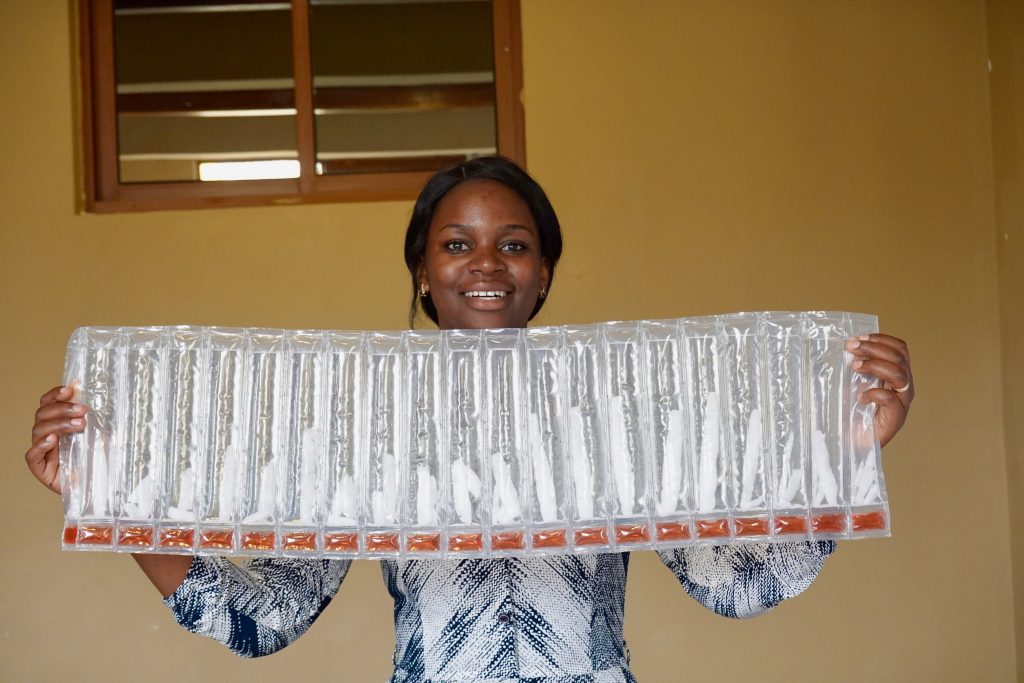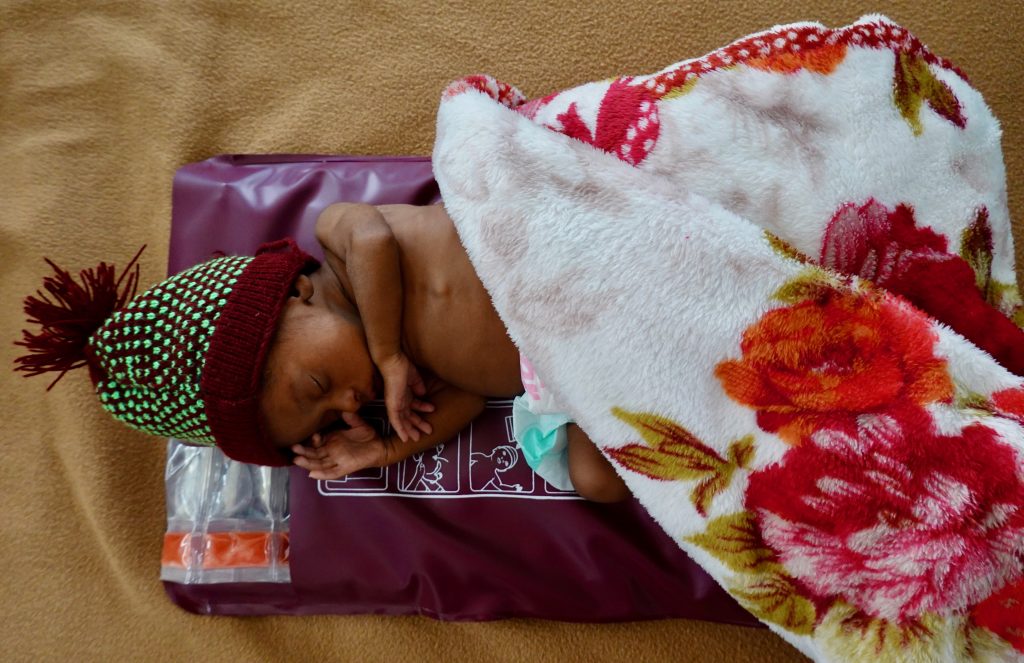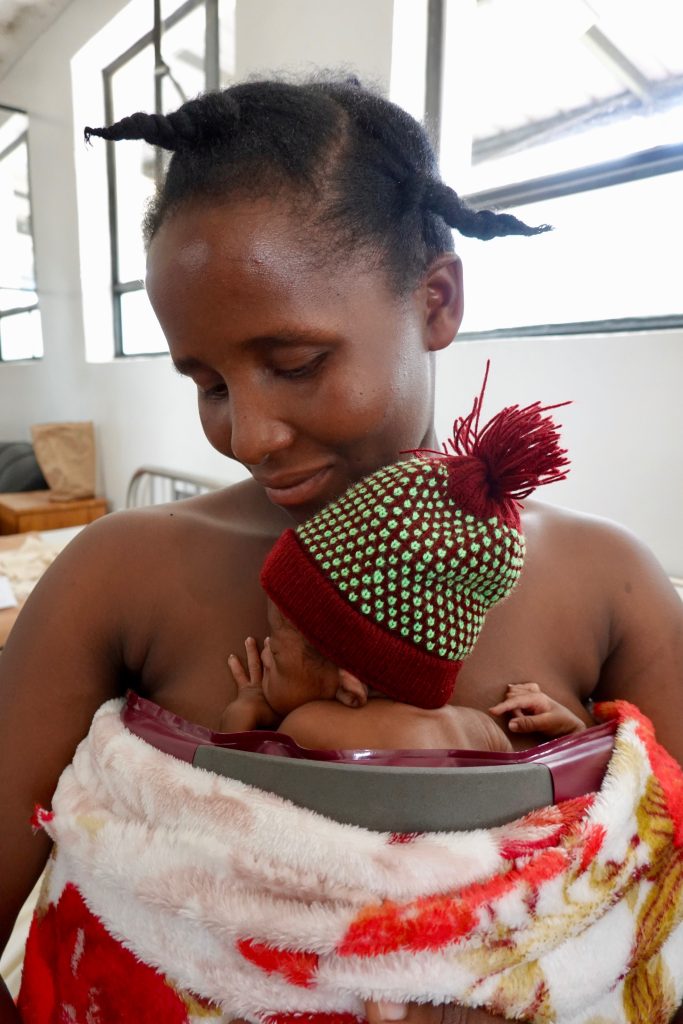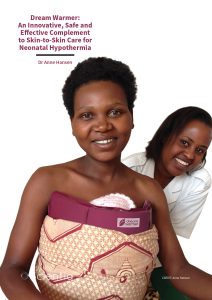Dr Anne Hansen – Dream Warmer: An Innovative, Safe and Effective Complement to Skin-to-Skin Care for Neonatal Hypothermia
Dr Anne Hansen is the Medical Director of the Neonatal Intensive Care Unit and Associate Chief of the Division of Newborn Medicine at Boston Children’s Hospital. With her colleagues, Dr Hansen has developed and tested a low cost, non-electrical warming mattress called the ‘Dream Warmer’ to help prevent and treat neonatal hypothermia in countries with limited medical resources. Her team has conducted extensive testing in Rwanda with results demonstrating that this medical device is safe, effective and ready for use on a wider scale.
Neonatal Hypothermia
Neonatal hypothermia occurs when a newborn baby’s body temperature drops below 36.5°C, and brings with it the risk of serious adverse effects on the baby’s health and even death. Babies who do survive may suffer from stunted growth, which can also impair brain development. While the ability to keep babies warm is taken for granted in rich countries, this can be surprisingly challenging in low and middle-income countries (LMIC), resulting in widespread neonatal hypothermia. Something of a silent killer, neonatal hypothermia is estimated to contribute to around 40% of, or one million baby deaths each year in LMIC.
Sick and premature infants are more likely to be affected. These babies rely on external heat sources to maintain a normal core body temperature. For preterm babies, it may take weeks to months for them to be able to maintain a normal temperature on their own. In countries with good medical resources, at-risk babies are placed in incubators or on warming tables. However, in LMIC these resources are often not available; neonatal hypothermia is estimated to occur in up to 85% of babies receiving hospital care in LMIC.
Dr Anne Hansen is the Medical Director of the Neonatal Intensive Care Unit and Associate Chief of the Division of Newborn Medicine at Boston Children’s Hospital. She has spent over a decade working with medical professions in Rwanda and through this work, recognised the overwhelming need for better neonatal care and treatment of hypothermia in LMIC.

Credit: Anne Hansen
Current Interventions
Currently, the World Health Organization recommends that Kangaroo Mother Care (KMC) should be used to provide heat for low birth weight infants. This method involves placing the baby directly on a family member’s chest (usually the mother’s) using direct skin-to-skin contact to provide warmth, as a mother kangaroo would do for the ‘joey’ in her pouch. This method is low cost and effective, also helping with bonding and milk production.
Dr Hansen fully supports this method as the gold standard for thermoregulation. She also acknowledges that mothers need to be supported to succeed at KMC because it heavily relies on the mother to provide a continuous source of heat over a potentially long period of time. There are scenarios in which KMC does not provide sufficient heat, and when the mother cannot be available for KMC due to illness or the need to conduct incompatible activities. In addition, if a baby is unwell, he or she may require medical examinations or interventions during which KMC would be difficult or infeasible. In response to these challenges to KMC, Dr Hansen and her colleagues looked to develop a low cost, non-electric warming device.
The team initially undertook a review to see if any adequate products were already in existence. They identified two neonatal warming devices, and these had similar specifications. However, several issues were identified involving preparation, cleanliness, compatibility with KMC, ability to access an infant for assessment or treatment, and finally, cost. Dr Hansen and her colleagues realised that to overcome these deficiencies they needed to develop and test a new product. This led to their collaboration with the Rwanda Ministry of Health to design and test an infant warming device.
‘Based on our extensive testing, we now have very strong evidence to support using the Dream Warmer on a wider scale…with the appropriate equipment, neonatal hypothermia is a preventable condition…’
Dream Warmer
Dr Hansen and her colleagues developed the Dream Warmer, a reusable mattress that is low cost and does not require electricity, operating similarly to a heating pad. The warmer is made of a wax phase change material that changes from liquid to solid at skin temperature. This plastic-encased, wax-based mattress is placed in a thermos of hot water for around 30 minutes until the wax is melted, and then into an insulating sleeve. Once the temperature indicator shows that it is at a safe temperature to be used, the baby can be placed directly on it like a mattress, or it can be wrapped around the baby’s back during KMC to provide additional heat. It stays at skin temperature for around 6 hours.
Unlike other warmers, the Dream Warmer allows medical staff and parents easy access to the baby, and because it has no attached fabric, it can be cleaned and reused even in settings without diapers or washing machines. The mattress is easy to prepare, clean and maintain; simple instructions are provided on the insulating pad and thermos to ensure comprehension even by those with low literacy skills. It can also be used in the delivery room for neonatal resuscitation, on transport to a higher level of care, or in the home setting.
Promising Results for Dream Warmer
Initially, the team undertook two pilot studies to test the safety, efficacy and feasibility of using the Dream Warmer. This testing took place in rural Rwandan hospitals and health centres where resources are often limited. In the first pilot study, published in 2018, the Dream Warmer was used on 102 different occasions with a total of 33 hospitalised infants who were either hypothermic or at risk of developing hypothermia based on their low birth weight. These early results were very promising: hypothermia was corrected in 95% of cases and prevented in 100% of at-risk infants.
In 2019, Dr Hansen and her team published the results of a second pilot study, this time in the health centre setting, and included interviews with mothers and nurses to understand their experiences with the warmer. Mothers reported that the warmers worked well and they liked being able to remain close to their babies and continue to breastfeed. Nurses reported that the warmer allowed good access to the baby and was beneficial for resuscitation. Both caregivers and nurses found the warmer intuitive to use and effective in keeping babies warm.
The biggest concern that was reported by some nurses was that they found the preparation time challenging. Dr Hansen has built this feedback into educational materials, emphasising the value of preparing the warmer in advance. In addition, after multiple uses, the research prototype warmers showed some signs of wear and tear leading the research team to find stronger materials and manufacturing techniques as they move to commercially available devices.

Credit: Anne Hansen
Building on Success
Following these two successful trials, Dr Hansen and her team brought the Dream Warmers to ten hospitals in a phased approach called a ‘cluster randomised stepped wedge’ study design. This approach was chosen because it is more robust and efficient for introducing a novel intervention in multiple sites in a low resource setting compared to the more common method in which all sites implement the intervention simultaneously. The researchers compared data obtained before and after introduction of the warmer, which from an ethical perspective avoided the need to deny infants use of the warmer once it was available. All infants were eligible to use the intervention if they either had, or were at risk of hypothermia based on low birth weight.
As with the previous studies, mothers were encouraged to use KMC alongside Dream Warmer. The primary outcome was the infants’ temperature, assessed by a nurse every 30 minutes until it had returned to normal, and then hourly. The secondary outcomes were survival to discharge, safety and feasibility.
Throughout the study period, 464 babies used the warmers on a total of 892 different occasions. In around half of these encounters, the warmer was being used by low birth weight infants. The results were once again very positive with the primary outcome showing that when the Dream Warmer was used, 79% of babies achieved euthermia (normal temperature), compared to 59% without. Interestingly, infants who did not use Dream Warmer also experienced an increase in rates of euthermia. A potential explanation is that this study increased the awareness of hypothermia, leading to the improved use of other interventions such as KMC and hats to improve the temperature of at-risk babies.
In terms of the secondary outcomes, mortality rates were much lower in those who had used Dream Warmer at least once; specifically, those who used the warmer had a mortality rate one third that of those who never used the warmer. Regarding safety, there were no adverse side effects such as burns, rashes or other skin irritation. Feasibility was also very good, with nurses having no instances of incorrect preparation, usage or cleaning of the warmer. The only problem noted was some minor leaking of wax on the inside layer of the plastic mattress (but with no wax leaking outside of the mattress).

Credit: Anne Hansen
Future Implementation of Dream Warmer
This was the first time a large-scale study had assessed a low-cost infant warming intervention. Overall, the Dream Warmer demonstrated good effectiveness, safety and feasibility, having undergone over 1,000 uses across all three studies. No adverse safety effects were identified and the warmer left only 8% of babies hypothermic. ‘Based on our extensive testing, we now have very strong evidence to support using the Dream Warmer on a wider scale. We are confident that this frugal technology will be an invaluable addition to the treatment of hypothermia in LMICs. With the appropriate equipment, neonatal hypothermia is a preventable condition and should be a key focus to reduce neonatal mortality and ensure that these vulnerable patients not only survive but thrive’ says Dr Hansen.
SHARE
DOWNLOAD E-BOOK
LISTEN TO THE AUDIO
REFERENCE
https://doi.org/10.33548/SCIENTIA765
MEET THE RESEARCHER

Dr Anne Hansen
Associate Professor of Pediatrics
Harvard Medical School
Boston, MA
USA
Dr Anne Hansen is the Medical Director of the Neonatal Intensive Care Unit and Associate Chief of the Division of Newborn Medicine at Boston Children’s Hospital. She is a graduate of Harvard Medical School and completed a residency in paediatrics at Boston Children’s Hospital, as well as a Fellowship in Neonatology at the Joint Program in Neonatology of Boston Children’s Hospital and Harvard Medical School. Dr Hansen’s research focuses on improving the care of seriously ill infants with an emphasis on global health, medical device development, and innovative approaches to treat neonatal conditions. Since 2010, she has worked in collaboration with the Rwanda Ministry of Health and Partners In Health to develop and implement their National Neonatal Protocol. Dr Hansen has developed a medical device called the Dream Warmer, to reduce neonatal hypothermia in countries with limited medical resources.
CONTACT
E: Anne.Hansen@childrens.harvard.edu
W: https://ghsm.hms.harvard.edu/faculty-staff/anne-hansen and www.globalnewborn.org
KEY COLLABORATORS
Rwanda Ministry of Health
Partners In Health
FUNDING
Banyan Gates Foundation
FURTHER READING
E Nahimana, L May, A Gadgil, et al., A low cost, re-usable electricity-free infant warmer: evaluation of safety, effectiveness and feasibility, Public Health Action, 2018, 8(4), 211–217.
L May, A Nshimyiryo, M Kubwimana, et al., Performance of a Nonelectric Infant Warmer in Rwandan Health Centers, Global Pediatric Health, 2019.
J Uwamariyaa, C Mazimpakaa, L May, et al., Safety and effectiveness of a non-electric infant warmer for hypothermia in Rwanda: A cluster-randomized stepped-wedge trial, Lancet EClinicalMedicine, 2021, 34, 100842.

REPUBLISH OUR ARTICLES
We encourage all formats of sharing and republishing of our articles. Whether you want to host on your website, publication or blog, we welcome this. Find out more
Creative Commons Licence (CC BY 4.0)
This work is licensed under a Creative Commons Attribution 4.0 International License. 
What does this mean?
Share: You can copy and redistribute the material in any medium or format
Adapt: You can change, and build upon the material for any purpose, even commercially.
Credit: You must give appropriate credit, provide a link to the license, and indicate if changes were made.
SUBSCRIBE NOW
Follow Us
MORE ARTICLES YOU MAY LIKE
Dr Ralf Adam | New Technologies Shaping the Future of Oral Hygiene
Understanding the efficiency of various toothbrush technologies is essential for achieving optimal oral health. Dr Ralf Adam, who leads a dedicated team at Procter & Gamble in Germany, is keen to investigate the complexities of these technologies. His team have provided new insights into the best toothbrush types for plaque removal and the maintenance of gum health. By highlighting the importance of informed oral care decisions and ongoing investigations, this vital research works towards ensuring everyone can achieve a brighter, healthier smile.
Dr Toby Phesse | Revealing the Mysteries of Wnt Signalling: Novel Approaches to Beating Cancer
Cancer remains a leading cause of mortality worldwide, and the need for new, more effective treatments remains an urgent challenge. Dr Toby Phesse from Cardiff University in the UK focuses on the role of the Wnt receptor found on the surface of cells and its involvement with cell communication and cancer growth, bringing fresh hopes for new therapeutic options.
Dr Vijay Reddy | The Virus World Database: An Invaluable Resource for Public Health and Healthcare
Severe viral disease presents an ongoing challenge to the health of humankind. While unparalleled developments in science and technology are improving our understanding of such viruses, this information needs to be readily accessible to researchers to ensure continued progress in public health and healthcare. Dr Vijay Reddy and his colleagues at the Hormel Institute (University of Minnesota) developed the Virus World database, an invaluable resource that details the genome, structure, and host of practically every discovered virus to date.
Professor Ralf Herwig | Deciphering the Enigma of Vitamin D and the Immune System
Vitamin D has been studied as a treatment for a large number of diseases and conditions, from cancer to autism to COVID-19. However, its mode of action is not completely understood. Professor Ralf Herwig carries out his research at HG Pharma GmbH (Austria) and Ulster University (UK). His vital work explores the role of vitamin D in the body with a view to unlocking its potential as a treatment for a variety of health conditions involving the immune system.





